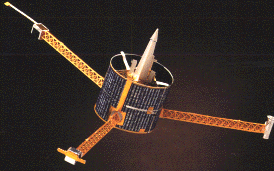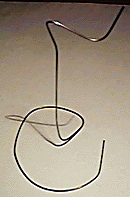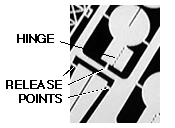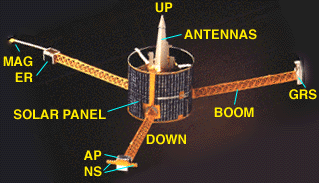Lunar Prospector
Space Craft SCIENCE KIT
Assembly Instructions
Version 1.3
|

|
The photo shows an assembled Lunar Prospector Space Craft (tm) SCIENCE KIT. Click the image for five more views. These instructions are for use with the two laser-cut Parts Sheets, with lithographed and metal-foil details in place, which are available for sale from SCI. The fully packaged kit, which includes instructions printed in black & white, with a Fact Sheet and Presentation guide, is also available.
YOU'LL NEED THE FOLLOWING:
- Small scissors, such as manicure scissors, to release the parts from the laser-cut parts sheets.
- Wooden toothpicks for applying glue.
- Glues. Use regular white glue (Elmer's Glue-All or equivalent). You might also try a thick white glue, sold in art and fabric stores, called "TACKY GLUE" (Aleen's or equivalent). A low-moisture glue, such as a glue-stick, will also be needed.
- A cylindrical object, about the size of a D-size battery, to use for bending a curve into the Solar Panel.
- Space. Set up a well lighted, comfortable work area, with room to set glued parts to dry.
- Time. Plan to set aside a few hours for unhurried assembly. It may take three hours or more to assemble your Lunar Prospector Scale Model.
- Patience. There may be some trying times. If so, remember that extra time and care will pay off with a surprisingly accurate, and handsome representation of NASA's Lunar Prospector, a sophisticated spacecraft.
- Optional: Spherical propellant tanks are represented in your model by intersecting flat circles. Although they are difficult to see once assembly is complete, you might want to locate or fabricate some 3-dimensional objects to replace them in your model. A ball of crumpled aluminum foil would work well, especially since the spacecraft's tanks are covered with aluminized thermal blanketing that looks somewhat like aluminum foil.
- Optional:
 You may wish to fashion a stand for your model. A simple stand can be made by bending a length of wire. Brass wire from a hobby store, or steel wire such as coat hanger wire, will work. About half a meter, or 18 inches, in length is plenty. Such a stand may also be convenient to support parts during assembly. If you choose to work with wire, be cautious to prevent eye injury, especially when cutting the wire, when fragments may fly. This image shows a stand made of soft iron wire obtained from a craft store.
You may wish to fashion a stand for your model. A simple stand can be made by bending a length of wire. Brass wire from a hobby store, or steel wire such as coat hanger wire, will work. About half a meter, or 18 inches, in length is plenty. Such a stand may also be convenient to support parts during assembly. If you choose to work with wire, be cautious to prevent eye injury, especially when cutting the wire, when fragments may fly. This image shows a stand made of soft iron wire obtained from a craft store.
- Optional: You might find it helpful to use an electric hair drier to set the glue in some places. If you do, be very careful not to blow the pieces apart.
BEFORE BEGINNING ASSEMBLY:
- Examine all the parts on both sheets, and read their names.

- Notice the RELEASE POINTS you'll need to clip to release parts from the parts sheets. Also notice HINGES, where parts will be folded.
- Read all of these instructions. Compare model parts with the illustrations.
- Have a look at the SCI Lunar Prospector Fact Sheet, and browse the Lunar Prospector Mission web site.
- Get your bearings: Examine the image of the spacecraft below. For the purpose of these instructions, "Up" will be defined as toward the COMMUNICATIONS ANTENNAS shown in the image. "Down" will be defined as toward the other end of the spacecraft. This is the basis for references to "Top," Bottom," "Above," Below", etc. in the instructions "Inboard" will be defined as toward the center of the spacecraft, and "Outboard" is defined as away from the center. References to the spacecraft's X, Y, and Z axes are shown on the spacecraft model parts.

IN GENERAL:
- If these instructions don't say which way to fold a piece, it may be folded in either direction.
- After releasing a piece from the Parts Sheets, trim off any remaining release points, but be careful not to remove tabs to be used in assembly.
TO ASSEMBLE YOUR MODEL:
Click on each step below for illustrated step-by-step instructions. Sections marked with a * may be accomplished at the same time if two or more people are working on assembly, or if you wish to work on one section while glue dries on another.
Congratulations!
YOU'VE FINISHED YOUR LUNAR PROSPECTOR Space Craft (tm) SCIENCE KIT.
Now that you're familiar with all of the spacecraft's major structures and its science instruments, be sure to browse the Lunar Prospector web site to learn more about the spacecraft, its mission, and its discoveries. Also, be sure to see the following from SCI:
ABOUT YOUR LUNAR PROSPECTOR SPACECRAFT MODEL:
Your model's scale is approximately 1/25. The model's three SCIENCE INSTRUMENT BOOMS can support themselves in one G, while the spacecraft's booms, made of thin fiberglass trusswork, cannot. The Lunar Prospector Spacecraft rotates about its central Z axis steadily at about 12 RPM.
Concurrent Steps
Sections marked with a * may be accomplished at the same time if two or more people are working on assembly, or if you wish to work on one section while glue dries on another.
| TOP OF THIS PAGE |


 You may wish to fashion a stand for your model. A simple stand can be made by bending a length of wire. Brass wire from a hobby store, or steel wire such as coat hanger wire, will work. About half a meter, or 18 inches, in length is plenty. Such a stand may also be convenient to support parts during assembly. If you choose to work with wire, be cautious to prevent eye injury, especially when cutting the wire, when fragments may fly. This image shows a stand made of soft iron wire obtained from a craft store.
You may wish to fashion a stand for your model. A simple stand can be made by bending a length of wire. Brass wire from a hobby store, or steel wire such as coat hanger wire, will work. About half a meter, or 18 inches, in length is plenty. Such a stand may also be convenient to support parts during assembly. If you choose to work with wire, be cautious to prevent eye injury, especially when cutting the wire, when fragments may fly. This image shows a stand made of soft iron wire obtained from a craft store.

